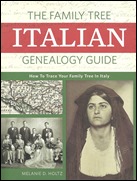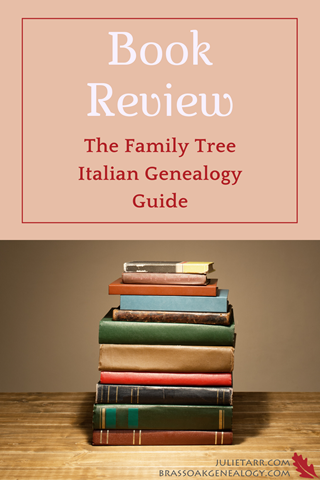 Title: The Family Tree Italian Genealogy Guide
Title: The Family Tree Italian Genealogy Guide
Author: Melanie D. Holtz
Format: Paperback
Published: 2017
My Rating: ![]()
![]()
![]()
![]()
The following review first appeared in the Federation of Genealogical Societies FORUM magazine (Spring 2019); reprinted with permission.
This post does contain affiliate links.
The Family Tree Italian Genealogy Guide is an invaluable resource for those researching their Italian roots. Melanie D. Holtz’s expert knowledge is thoughtfully presented in an upbeat manner that will encourage readers to dig deeper.
The book is organized into four parts. In the first part, readers will find a great discussion on the motivations that led to Italians emigrating, including those who intended to return to Italy (usually referred to as “birds of passage”). There is also a sidebar that identifies countries, other than the United States, to which Italians immigrated. Also included in this part are basic research methods, as well as strategies for finding the ancestral home town in Italy with a simple case study to illustrate.
Part 2 is all about Italy. First, there is a brief, but detailed, history of what is now Italy. This information helps readers understand emigration motivations and what records may exist in certain places and time periods. There is a handy timeline, as well as tips and resources for studying a particular region. Next, readers learn about three levels of jurisdiction, what records were kept in each, and where to find the records today. There’s a helpful map illustrating the regions and provinces, along with a section on finding maps and gazetteers. The part concludes with a chapter on deciphering the Italian language. Here, readers will find resources for learning the basics of the Italian language and tips for reading Italian handwriting (along with several illustrative examples). There’s also a section on naming traditions, which also includes common abbreviations for given names. Another section provides information regarding the origins of Italian surnames.
Part 3, chapters 7 through 12, is all about Italian records, including their history and where they can be found. In chapter 7, readers will learn about civil records including birth, marriage, and death records. Of note is the discussion of marriage promises, which were found before unification in the areas tied to the Kingdom of Two Sicilies—this will come in handy for me personally when I get into pre-unification research in that area. Chapter 8 discusses Roman Catholic church records including baptisms, confirmations, marriages, and deaths/burials. Of particular interest were records called “state of the souls,” which contain information on family groups (I have come across similar records in my German research, but was unaware of this resource for Italian research, until now, that is). There are brief discussions on other religions including Jewish and Waldensian. Chapter 9 discusses censuses and taxation records. It’s broken down by early censuses (pre-1700s), regional censuses (1700s to 1860), and post-unification censuses (1871 to present). This chapter will help readers understand what may be available for a particular area and time period and where one might find the records. In chapter 10 Holtz provides an in-depth discussion of notarial records, which are essentially legal documents. Readers will learn just how valuable these records are, as well as how to find and use them. Chapter 11 discusses the different types of military records (draft/conscription, extraction list, muster rolls, and service records), including where to find them and how to use them. The final chapter in part 3 discusses a plethora of other Italian records—newspapers, directories, university records, and municipal records. The municipal records include those related to occupation, political affiliation, decrees, and travel papers and border passes. Holtz explains why these records are useful for genealogy research and how to access them.
The last part brings everything together and offers additional techniques for solving tough research problems. Three short case studies demonstrate many of the strategies and records presented in the book.
In addition to an index, readers will find four appendixes. The first contains various resources, the second contains a listing of Italian provinces and archives, the third contains sample letters in Italian (one to request records and one to request a research appointment), and the fourth contains a handy word list that has common genealogical terms in English, Italian, and Latin.
Overall, Holtz provides excellent information in order to successfully and efficiently research Italian ancestors. There are many challenges researching Italian ancestors and Holtz does a good job of calling out the records’ idiosyncrasies that may impact research. There are sample images of various record types, oftentimes including translations and sometimes transcriptions. Also, each chapter concludes with a “keys to success” section that highlights important takeaways. This is an excellent resource for those who are new to researching Italian ancestors or for those who are looking to dig deeper and explore additional Italian resources.



Share your thoughts...